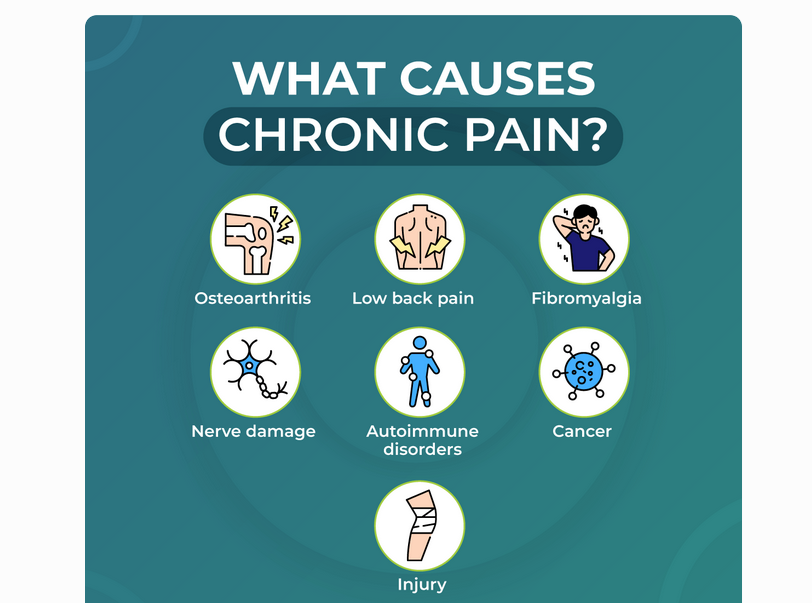Chronic pain is a complex condition that requires a multidisciplinary approach to management. Treatment options may include medication, physical therapy, psychological counseling, or surgery, depending on the underlying cause and severity of the pain. In recent years, stem cell therapy has emerged as a promising treatment for chronic pain, with the potential to regenerate damaged tissues and reduce inflammation. It is important to seek medical attention if you are experiencing chronic pain, as early intervention can improve outcomes and prevent long-term complications.
Chronic pain is a long-lasting pain that persists for more than 12 weeks, even after the initial injury or disease has healed. It is a complex condition that affects the nervous system and can be caused by various factors, including injury, disease, inflammation, or aging. Unlike acute pain, which is a normal response to injury or tissue damage, chronic pain is a persistent and ongoing discomfort that can significantly impact an individual’s quality of life.
There are several types of chronic pain, including neuropathic, nociceptive, and centralized pain. Neuropathic pain is caused by damage or dysfunction of the nervous system, resulting in tingling, burning, or shooting sensations. Nociceptive pain, on the other hand, is caused by tissue damage or inflammation and is characterized by throbbing or aching pain. Centralized pain, also known as fibromyalgia, is a condition in which the central nervous system becomes hypersensitive, causing widespread pain and discomfort.
Chronic Pains are Categorized by Type or Cause
Here are the main types of chronic pain, grouped by their origin or underlying mechanism:
1. Nociceptive Chronic Pain
Caused by tissue damage or inflammation.
- Musculoskeletal pain – e.g., arthritis, low back pain, fibromyalgia
- Visceral pain – from internal organs (e.g., irritable bowel syndrome)
- Inflammatory pain – from autoimmune diseases (e.g., rheumatoid arthritis)
2. Neuropathic Chronic Pain
Caused by nerve damage or dysfunction.
- Peripheral neuropathy – from diabetes, shingles (postherpetic neuralgia), trauma
- Central pain syndromes – after stroke, spinal cord injury, multiple sclerosis
- Complex regional pain syndrome (CRPS) – chronic nerve pain in a limb
3. Nociplastic Pain (or Centralized Pain)
Pain without clear tissue or nerve damage but involving altered pain processing.
- Fibromyalgia
- Chronic fatigue syndrome
- Some cases of chronic pelvic pain or tension headaches
4. Mixed-Mechanism Pain
Involves more than one pain type.
- Cancer-related pain
- Chronic post-surgical pain
- Chronic back pain (often a mix of nociceptive and neuropathic)
What Causes Chronic Pain?
There are various causes and types of chronic pain that can affect individuals. One of the most common causes of chronic pain is musculoskeletal conditions such as osteoarthritis, fibromyalgia, and lower back pain. Other causes include nerve damage, autoimmune disorders, and certain cancers. Chronic pain can also be a result of an initial injury that did not heal properly.

Chronic pain is caused by a wide range of conditions or processes that affect the body’s tissues, nerves, or brain. Below are the main causes of chronic pain, organized by category:
1. Tissue Injury or Inflammation (Nociceptive Pain)
When tissues like muscles, joints, or organs are damaged or inflamed.
- Arthritis (e.g. osteoarthritis, rheumatoid arthritis)
- Injuries that didn’t heal properly (e.g. sprains, fractures)
- Surgery or trauma with long-term effects
- Endometriosis or inflammatory bowel disease (IBD)
2. Nerve Damage or Disease (Neuropathic Pain)
When the nervous system is injured or dysfunctional.
- Diabetic neuropathy
- Postherpetic neuralgia (after shingles)
- Sciatica
- Multiple sclerosis (MS)
- Stroke or spinal cord injury
3. Abnormal Pain Processing (Nociplastic Pain)
When the brain and spinal cord process pain signals abnormally, often without clear tissue or nerve damage.
- Fibromyalgia
- Chronic fatigue syndrome
- Irritable bowel syndrome (IBS)
- Tension headaches or migraines
4. Cancer and Cancer Treatments
Pain caused by tumors pressing on tissues or nerves, or from chemotherapy, radiation, or surgery.
5. Psychological and Lifestyle Factors
Pain can be worsened or prolonged by:
- Depression or anxiety
- Chronic stress or trauma
- Poor sleep
- Sedentary lifestyle
These don’t cause pain directly but can amplify or sustain it through nervous system sensitization.
6. Unknown Causes
In some cases, no clear cause is found, especially with conditions like fibromyalgia or chronic widespread pain.
